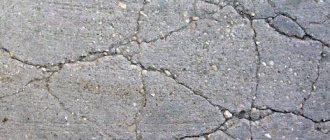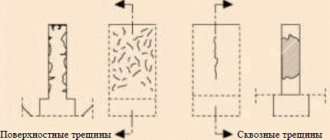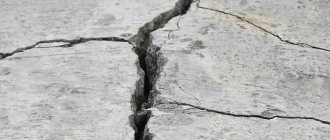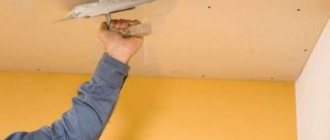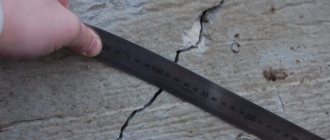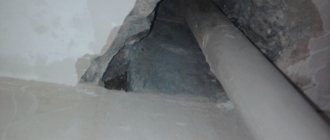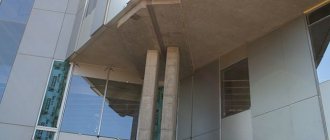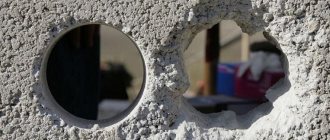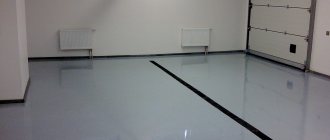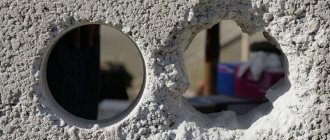Concrete coatings are used in a variety of areas: when installing floors, concreting surfaces in both industrial and residential buildings, constructing highways and much more. However, concrete has a low tensile strength, so during the hardening process the mixture contracts slightly and shrinkage of the structures occurs. Because of this, minor and more serious defects appear on the surface. In this case, sealing of cracks in concrete is required, which is performed using different technologies depending on the type of damage and the cause of its occurrence.
Types of cracks in concrete
Some novice or unscrupulous builders prefer to simply cover up a hole or any other defect with putty or mortar. However, before you repair a hole or crack in a concrete wall or other foundations, it is worth understanding what exactly caused such troubles to occur.
There are several types of defects:
- Superficial. Such cracks often appear after pouring the foundation during the drying of the sand-cement mortar, if the mixture was prepared without observing the required proportions of the components, low-quality components were used, or there was not enough water in the mixture.
- Shrinkage cracks (also called hairline cracks). Defects of this type are considered the most dangerous, since they cause not only deformation of the fundamental foundation, but also the entire building as a whole. This leads to a decrease in strength. Defects of this type appear when there is an uneven load on the foundation and when the cement composition is incorrectly selected.
- Temperature-shrinkable. Cracks of this type appear during the hardening process of the concrete base due to the exothermic reaction occurring between cement and water. Very often, when constructing walls and ceilings, novice builders do not take into account the freedom of deformation, as a result of which temperature stress occurs in the concrete mass and defects appear on the surface.
- Cracks and holes appearing due to poor quality reinforcement. If the frame for strengthening the structure is too weak, it will bend under loads, which will also lead to the formation of defects. In addition, the reinforcing rods may begin to oxidize. Due to corrosion, the material increases in size, tearing the concrete mass from the inside.
Concrete surfaces located outdoors are also susceptible to cracking. The external environment contains chemically active substances that create favorable conditions for the appearance of defects.
In addition, sharp temperature changes, which can occur both on the surface and in the thickness of the concrete, have a destructive effect. In this case, not only cold air, but also ultraviolet radiation has a detrimental effect.
It is also worth paying attention to the width of the cracks, since in some cases such defects are not critical.
How to strengthen brick walls
Scheme for dressing brick walls
Advice: If there are no results after repairing the walls, it is necessary to partially re-lay them.
To guarantee the strength of a cracked brick wall, it is advisable to strengthen it from the inside of the building.
This means:
- Sealing the crack.
- Putting a lock or metal profile on it.
- The lock is attached to the wall with anchors, and the gap is closed across it, which will prevent its expansion in the future.
- Repairs can be made with metal staples; their ends should go into the wall to a depth of at least 1/2 the thickness of this wall, in which holes for the staples should be drilled in advance.
- Within a day, such a repaired wall can be put into operation. But in any case, you cannot load it too much - the wall will only gain full strength in a month.
If the cracks appeared due to an improperly poured foundation, the best solution would be to strengthen the foundation with an auxiliary concrete belt.
- A trench is dug around the entire perimeter of the house with a depth greater than the depth of the foundation.
- The auxiliary belt will be placed in it.
- To prevent further cracks from forming in the masonry, the base is poured using the appropriate technology.
What kind of cracks there can be in brick walls, their cause, and how to eliminate them can be learned from the video in this article. Cracks in brickwork are very common. The cost of solving this problem varies, but it is worth getting rid of it immediately to avoid compromising the structural integrity of a residential building.
Graduated from the Faculty of Architecture of the Penza State Institute of Architecture and Construction. For the last ten years, he has been a leading specialist in a large construction company in Penza, engaged in the construction of multi-storey residential buildings. Total work experience in the specialty is 18 years. Consults on design issues, selection of materials for interior and exterior decoration, and technology for finishing work.
Acceptable crack sizes
In the construction industry there is such a definition as the permissible crack opening width, which is determined according to DBN V.2.6-98:2009 based on operating conditions:
- The crack size should not exceed 0.5 mm if the concrete surface is not exposed to weather conditions. That is, it is not affected by moisture, low temperatures and ultraviolet radiation.
- The permissible crack opening width cannot be more than 0.4 mm, provided that the structure is exposed to weather influences.
- The width of the crack should not exceed 0.3 mm if the concrete base is located in an aggressive environment.
- It is not recommended to allow the formation of gaps larger than 0.2 mm when we are talking about reinforced structures that are characterized by reduced resistance to corrosion.
Horizontal cracks with a small opening, which often appear in reinforced concrete columns, are also considered harmless.
However, it is important to take into account that there are certain operating conditions under which cracking is not allowed at all:
- if we are talking about reinforced concrete structures that constantly interact with liquids and gases (that is, they must be impenetrable and airtight);
- when using structures that are subject to more stringent requirements for their durability.
Having determined the type of defect and the need to correct it, it is much easier to choose than to repair holes in a wall or any other concrete surface.
Cement mortars
These compounds are very popular due to their low cost and ability to repair minor shrinkage cracks in concrete.
Repairing a crack
Before you begin sealing, you need to check the crack itself for chips around it. If there are any, then in the near future they may turn into holes, so it is imperative to remove all peeling pieces of concrete. After this you need:
- Perform jointing. To do this, using a chisel and a hammer, you need to walk along the entire length of the crack so that its depth is at least 5 mm. If necessary, you can use a spatula to create a depression.
- Remove dust using a vacuum cleaner and rinse the resulting depression with water.
- Remove excess water and cover the crack with cement mortar (3 parts sand to 1 part cement with the addition of PVA). In this case, you need to ensure that the composition covers the entire space of the recess.
- Moisten the poured cement with water.
Filling the hole
If a hole has formed in the concrete surface in which the reinforcement is visible, the defect can be repaired as follows:
- Clean the hole in the concrete and treat its surface with an anti-corrosion compound.
- Place pieces of steel wire about 4 mm in diameter into the recess.
- After this, the recess is covered with a primer, applying it evenly over the entire surface. In this case, the thickness of the mixture layer should be about 3 mm.
- Without waiting for the mixture to dry, fill the hole with a cement compound for sealing cracks in concrete and make sure that it fills the entire hole. If the hole is too deep, then cement is poured in several stages. In this case, each subsequent layer must be moistened with water from a spray bottle.
- Level the surface with a lath (metal or wood), moving the tool from right to left.
- After the mixture has hardened, excess cement composition must be removed with a spatula and the surface must be plastered. If the crack was too deep, then leveling is done using a grinding machine.
Healthy! The cement composition must be poured with a reserve so that it is slightly higher than the floor surface. The mixture will shrink as it hardens.
After 24 hours, the concrete floor can be painted or any finishing material can be laid on it.
However, it is worth considering that such sealing of cracks in concrete will not provide a sealing effect and is not suitable for surfaces that have increased waterproofing requirements. In addition, the cement composition can be considered as a temporary solution to problems. Sooner or later the defects will appear again. If you want to “overhaul” the holes and avoid their occurrence in the future, then in this case you can repair the defects using resins, specialized repair compounds based on them, or sealant.
Manufacturers
The list of popular repair compounds includes products from the following manufacturers:
- Ceresite;
- Penetron;
- Basf;
- Birss;
- Consolidated Bars;
- Siltek;
- Knauf;
- Industry;
- Mapei.
Ceresit
The manufacturer Ceresit produces different types of building mixtures for concrete foundations. The Ceresit CX5 mixture is a restorative mixture, suitable for repairing concrete structures at high humidity. The product does not shrink significantly when hardened and used, and can withstand changes in temperature conditions. The coating is resistant to high humidity and reliably hides defects. The cost of the composition is high - about 2500-3000 per package of 25 kg.
The composition of Ceresit CN 88 is intended for leveling floor coverings and is durable. The product is laid out in a layer of 5-50 mm and can be used indoors and outdoors. The mass is quickly leveled, the surface can be used 6 hours after restoration. The product is wear-resistant, suitable for mechanized spraying, and environmentally friendly in composition.
The product is suitable for leveling screeds and restoring foundations that can withstand high loads. The mass is suitable for manual application to the coating.
The minimum layer thickness is no less than 35 mm; on the sound and heat insulating layers, the product is laid out with a thickness of no less than 45 mm. Can be used as a base for laying finishing material.
Penetron m500 bond mixture
Concrete repair compositions from the Penetron brand are dry mixes. The formula contains processed quartz sand, fine-grained Portland cement, polymer compounds to improve the elasticity of the product, and mineralized fiber fibers. The mixture must be diluted in the proportions of 170 g of water per 1 kg of powder. Laying the mass is carried out at a temperature of at least +5°C. The surface must be washed with clean water.
The product is laid out in a thickness of 5-35 mm, consumption is carried out in proportions of 1.8 kg per 1 m². The composition can be laid out in several layers, the second coating is applied after 4 hours. It takes 120-150 minutes for the layer to harden. After 28 days, the patch increases water resistance to W14, the strength category is 50 MPa, the adhesion level is up to 1.3 MPa.
Blend Parade
Parad brand compositions are intended for urgent repairs of concrete structures; the coating thickness can reach 60 mm. Laying can be done at a temperature not lower than +5°C. The advantage of the product is the rapid setting of the composition and the high strength of the patch.
After 1 day, the strength of the layer reaches 20 MPa; after 1 month, the coating acquires a strength parameter of 70 MPa, the frost resistance level is F200.
The product is universal, suitable for different types of structures (anchors, foundations, joints, road slabs, hydraulic structures, drinking water tanks).
Emaco
Repair mortar for concrete floors Emaco brand Basf is used for structures of various levels of complexity. Emako N 5100 is suitable for minor deformations (cracks, chips). Products N 900 and N 5200 are suitable for eliminating defects of medium complexity (cracks, collapsed areas).
Products S 5400, S 488 are used to eliminate damage due to the corrosion process, closing cracks up to 40 mm. The company also offers compositions for damaged concrete surfaces with exposed reinforcement bars and large chips.
The manufacturer has developed frost-resistant, non-shrinking, anti-corrosion compounds. The price in Moscow is 850-1800 rubles. for 1 package.
Birss Russia
The concrete repair mixture from the Birss brand is universal and can be used for surfaces of different levels of complexity. Products 28, 29, 30, 30N are applied to eliminate cracks and deformed coatings. Special products (30С1, 59С2 and 58С1) are intended for medium wear surfaces; mixtures 59S3, 59Ts, RSM, RBM, 600VRS are used in case of major damage to structures.
The compositions have frost-resistant characteristics, are used at sub-zero temperatures, have high strength of bonding of elements, have water-resistant characteristics, high density, and plasticity.
Consolid Bars
Products for surface restoration Consolit Bars are suitable for panels located vertically and on floor coverings; the mass quickly holds surfaces together, does not shrink, and has high adhesion. The product line includes self-leveling, thixotropic (for restoration of wall panels), finishing, waterproof and reinforcing mixtures. The cost of production is 800-1500 rubles. per package 30 kg.
Knauf
Products for concrete repair from the Knauf brand are environmentally friendly, do not contain toxic substances, are durable, provide surface waterproofing, and have water- and vapor-proof characteristics. The mixtures are sold in compact packages (5-6 kg). The products are universal and are used for external and internal repair work. The cost of packaging (5 kg) is 350-500 rubles.
Industry
Indastro products are universal and are used for repairs, restoration of structures on foundations, restoration of road surfaces, etc. The composition ensures strong joining of elements, is durable, wear-resistant, does not have strong shrinkage, is water-resistant, and frost-resistant.
Mapei (Italy)
The mixture from the Mapei brand ensures that restoration work can be completed in a short time, does not shrink during hardening, does not deform, and prevents abrasion of surfaces. The special SW series is suitable for reinforced concrete structures and is resistant to temperature changes, precipitation and moisture. After hardening, the coating layer acquires anti-corrosion properties and is suitable for waterproofing work.
The manufacturer's range also includes mixtures:
- epoxy;
- with the addition of resins;
- with high plasticity;
- for repairing cracks;
- for restoration of ceilings;
- for repairing airfield ceilings, tunnels, production workshops, highways.
The product price is about 850-1500 rubles.
Mount Crystal
Mountain Crystal products are intended for the reconstruction of concrete floor surfaces, reinforced concrete floors, walls lined with foam concrete and aerated concrete blocks. The mass is used to seal cracks and placed in areas of chips, holes, voids and traces of erosion. The product is suitable for restoring walls, floor coverings, and ceilings.
Siltek
The manufacturer Siltek offers a composition for repairing defects in surfaces and finishing seams between panels. The materials are frost- and water-resistant, quickly harden, durable, and wear-resistant. Reinforced microfibers are included in the formulas of some products. Products are certified.
The particle size in the mass reaches 2.5 mm, the thickness of the coating reaches 30 mm, after 3 days the strength of the layer reaches 15 MPa, after 28 days - 35 MPa. The product is suitable for use within 30 minutes after dissolving in water.
Frost resistance parameters reach at least 200 cycles, shrinkage does not exceed 1.2 mm/m, abrasion characteristics do not exceed 0.5 g/cm2.
The permissible operating temperature is -30…+70°С. After 3 days, the bending strength parameters reach 3 MPa, after 28 days - no less than 5 MPa. The strength of bonding to the surface is not less than 2.0 MPa.
Long-term repair of defects
When deciding how to repair cracks in concrete for a long time, you should pay attention to this method of treating defects. Resin and sealing mixtures based on it are suitable for restoring screeds, blind areas and various concreted areas or horizontal surfaces.
Repairing cracks in concrete using such compounds has a number of advantages. First of all, this is the low cost of the mixtures, as well as their quick drying. On the other hand, the resin allows you to securely fix the seams and keep them from subsequent enlargement.
So, to eliminate defects you will need to prepare:
- angle grinder and diamond-coated discs;
- vacuum cleaner;
- spatulas and a trough for diluting the composition;
- primer composition for concrete;
- Epoxy (base A and hardener B);
- Fine-grained sifted sand.
Before you repair a crack, you need to clean it of dust and dirt. After this, we carry out the sealing in the following sequence:
- We repair the crack. In this case, the width of the resulting recess must be at least 5 mm.
- Using a grinding machine, we cut transverse seams in the concrete in increments of 400 mm (the length of the grooves is about 100-150 mm).
- We remove the loose layer of concrete and remove dust from the surface using a vacuum cleaner.
- We treat the surface of the defect with a primer, and fix the transverse grooves using repair brackets.
- We prepare a solution from resin (base), hardener and sand according to the instructions on the packaging with the composition.
- We fill the defect with the resulting mixture and quickly level the surface, since the setting time of the resin is only 10 minutes.
After this, it is recommended to fill the surface with sand, which will need to be removed with a vacuum cleaner before plastering the base or covering it with finishing material.
The best epoxy compounds
If we talk about the best materials for repairing cracks in concrete walls and other surfaces, the most effective today are considered to be:
- Domestic epoxy resin ED-16 and ED-20 costs about 2,000 per 3 kg. The hardener will have to be purchased separately (costs about 300-500 rubles).
- Epoxy 520 resin from the Czech manufacturer Spolchemie costs 3,500 rubles per 5 kg.
- German composition UZIN KR 416, which will cost 2,700 rubles per 0.75 kg.
Also very popular are compositions from the Italian manufacturer Sika.
However, it is worth considering that this method of correcting defects is not suitable for treating holes that form in concrete foundations under strong pressure from water. In this case, it is worth using a sealant.
Basic rules for screeding houses
Steel corners
In a finished building, a screed is necessary to prevent the appearance of new cracks, as well as to ensure that existing damage does not increase. The technology has proven itself to date. To screed a house with dimensions of 6x6 meters and a height of 3 meters, you will need the following materials:
- Steel corners 10x10 cm – 4 pcs. 3 m each.
- Rods in diameter from 16 mm – 48 m.
- Thick-walled pipe, diameter similar to rods - length 1.5 meters.
- Threaded rods for rods – 16 pcs.
- Nuts and washers – 16 pcs.
Threaded studs
To tighten the house, you need to install metal corners at the corners of the building. Sections of thick-walled pipes are pre-welded onto them. Studs are fixed to the rods, and after that the entire structure is tightened with nuts. To ensure the reliability of the entire structure, some rules should be taken into account:
- After a year of such a tie, you need to check and tighten the nuts. It is recommended to repeat this procedure every summer.
- Before installing the rods, you will need to make the correct calculations. This will allow the entrance doors to open normally.
- Consecutive tightening of all nuts will help avoid distortions in the structure.
- The thicker and wider the metal of the corners, the more reliable the screed against cracks in the walls will be. Don't skimp on corners.
- If the house is decorated with different decorations and other decorations, then before installing the structure you should prepare a place for the corners so that they fit snugly against the wall.
- When installing yourself, it is recommended to secure the corners with self-tapping screws directly to the wall. This allows you to fix the corners and tighten the nuts securely.
For clarity, it is worth looking at the screed of the house against cracks in the walls in the photo. This will allow you to understand the fastenings and the structure as a whole:
After the work is completed, the house can be decorated with finishing materials, such as siding, but access to the nuts can be left for tightening them.
Use of sealants and self-expanding tapes
It’s worth saying right away that this method of sealing defects is very expensive, so it is most often used when repairing concrete bowls of country pools. However, despite its high cost, the use of sealant and self-expanding cords has its own advantages:
- the ability to process any type of defect;
- complete tightness;
- the ability to carry out installation work in cold weather conditions.
To work, in addition to the standard set of tools, you will need:
- mounting gun;
- self-expanding tape or cord;
- chisel and brushes;
- sealant for concrete.
However, before covering up the flaw, you need to measure the dimensions of the cracks and purchase the right type of sealant and tapes depending on this. For example, if the hole depth is 60 mm, then an 18 x 23 mm cord will do.
The next step is necessary:
- Expand the cracks and remove dust.
- Install the cord into the recess.
- Fill the remaining space with sealant.
- Smooth out the protruding compound using a spatula.
After completing the work, you won’t have to guess how to putty the surface or caulk it. It is enough just to apply the composition and smooth it out.
If we talk about the best compositions of this type, the most popular are:
- Domestic ELASTOSIL PU 20 costs 280 rubles per 600 ml.
- The composition is from the French manufacturer Rubberflex, which today sells for 300 rubles per 310 ml.
- PLOW tape made in Russia costs about 260 rubles per linear meter.
Self-production
You can make a repair composition for concrete yourself for work on the arrangement of a private house, outbuildings, etc.
You will need to mix the following components:
- 1 part cement powder;
- 3 parts clean fine sand;
- glue (PVA or Bustilat) with water in proportions 1:3.
You need to mix sand and cement powder, mix with other ingredients and prepare a homogeneous mass. When mixing, use a special mixer. The composition is prepared on the eve of work to prevent pre-hardening. The mixture is suitable for finishing floor coverings, vertical panels, etc.
Injection
Also, when deciding how to seal holes in a concrete wall in the most effective way, especially if not only a crack has appeared, but also water is flowing through it, you should pay attention to this method.
Injection technology involves introducing a special composition (polyurethane or epoxy resin, microcement or waterproofing mixture) into the thickness of concrete using special injection pumps that create strong pressure.
To perform such restoration of defects it is necessary:
- Make holes in a staggered pattern on both sides of the gap.
- Install packers in them (special tubes through which the solution is supplied, reminiscent of a dowel) at an angle.
- Pour in the solution.
- Pull out the tubes and cover the surface with the building compound.
So, we looked at how to fix a hole in a concrete wall yourself, but what if we are talking about aerated concrete?
What factors lead to damage to concrete paths poured in the garden?
In addition to the process of natural wear and tear, other factors threaten the appearance and functionality of concrete paths, due to which owners have to deal with the restoration of the surface quite often. Among them:
— temperature changes;
— high level of humidity;
— errors made during the construction of the base of the trail;
— location of trails on problematic soils, etc.
Damaged concrete path
Features of sealing cracks in aerated concrete
Cracks form in aerated concrete as often as in conventional cement-sand monoliths. To seal them, work is performed in the following sequence:
- A layer of destroyed building material is removed from a wall or any other aerated concrete surface and cleaned of dust and dirt.
- The gap is primed. To do this, it is recommended to use a 50% aqueous dispersion of PVA and water (1:3 ratio).
- Cracks are sealed depending on their size. If the damage is single and its width does not exceed 0.4 mm, then the gap is widened to 10 mm and any building compound is poured into it (you can use cement or special adhesive for aerated concrete). If the width of the defect is up to 10 mm, then it is better to use a porous adhesive composition for sealing and widen the gap to 20 mm. If a defect up to 20 mm wide appears, it is recommended to use an adhesive or cement composition, after adding coarse crushed stone from aerated concrete.
After completing the work, it is necessary to cover the treated surface with a sheet of plywood (secure with self-tapping screws) for 3-5 hours.
Useful tips
Regardless of what exactly is used to seal cracks - homemade putties, putties or sealants, there are uniform rules.
Knowing the rules, the work on sealing cracks will become better and more durable:
- Carry out such events in the warm season, at above-zero temperatures.
- Before applying any composition, thoroughly clean the surface to be treated from debris, dirt and dust.
- Make sure that the tree is not wet after rain. Choose dry weather for such events.
- If the split is serious and large, pre-glue its edges with masking tape. This will prevent the composition from reaching other places.
- If sealant is accidentally spilled on the surface, wait until it dries and carefully clean the area with sandpaper.
- After finishing the work, the former crack is moistened with water and leveled (you can use a brush). This will give the log a neat and smooth look.
What means would you use to repair cracks in logs?
People's Professional
When planning to build a cottage, house or bathhouse from a log house, select only high-quality logs. It is better if they come with pre-treatment with antiseptic compounds and after prolonged drying. This will protect the wood not only from splitting, but also from the appearance of mold and fungal colonies.
- How best to get rid of mold on wood: types, causes, overview of control methods, sequence of actions to eliminate the problem, as well as measures to prevent recurrence
- How to choose the best decking board: types, criteria for choosing products from natural and heat-treated wood and WPC, review of reliable manufacturers
- The best way to treat wood to protect it from rotting: chemical compositions, antiseptics, how to choose the optimal composition, their pros and cons
